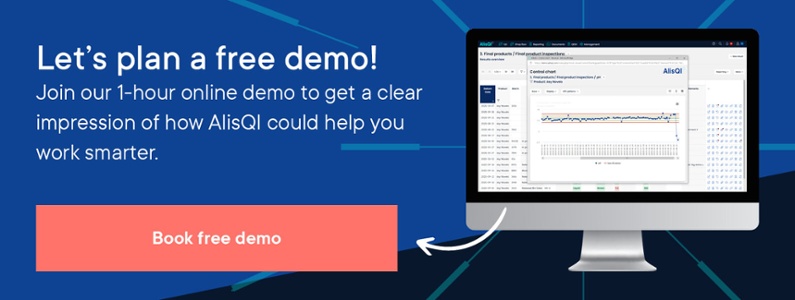Solvers help you monitor quality, apply SPC, manage equipment, and ensure traceability.

5S Lean Methodology – how can it improve a manufacturer’s day-to-day
There are plenty resources talking about what 5S is and the history behind it. And, while most manufacturers know that 5S is a Japanese Kaizen approach used to boost productivity and efficiency – the details on how it can be put into practice may still be blurry.
This article highlights the different ways 5S helps manufacturers improve their day-to-day and talks about the benefits of combining this methodology with a cloud-based Quality Management System (QMS).
What are the 5S's?
A quick lesson in Japanese and we learn that the 5S’s stand for: Seiri (Sort), Seiton (Set in order), Seiso (Shine), Seiketsu (Standardize), and Shitsuke (Sustain). It doesn’t matter whether you’ll remember the Japanese words or their English equivalent as long as you know what the 5S’s represent and how they can be adapted to your workplace.
Sort – Organize and streamline
Let's start with 'Sort' and 'Set in order' and a few steps that you can take to ensure these are well done:
- Do a walkthrough of your workspaces and note down any obvious issues
- Remove unnecessary items from the workspace
- Organize tools and materials so they're easily accessible
- Apply visual labels and designated areas to cut down on time spent searching for items.
A good example of ‘Set in order’ is to implement a shadow board system. This means giving each tool a designated, outlined space. This is ideal for factories in which workers use a lot of individual hand tools. It helps reduce tool search time considerably.
The ‘’Sort” and “Set in order” steps don’t only apply to your physical space, factory layout, or tools. Improved access to data and information, automatic workflows, and using templates for instance, can save time and add to efficiency.
Manufacturers should also incorporate the ‘Sort’ concept into their operations by monitoring waste reduction. A waste audit highlights parts of a process that are in most need of change. You can then focus on minimizing defect rates and sorting, reusing, or recycling waste materials, helping you reach sustainability targets.
Shine – Maintain and prevent
'Shine' doesn’t just mean keeping your equipment and workspaces clean. You can also think in terms of preventive maintenance.
Scheduling regular cleaning and inspection of equipment will help to prevent machine failure and downtime. Implement routine tasks such as Clean, Inspect, Lubricate (CIL) to keep your equipment in good condition every day. Maintaining your equipment well not only keeps the workplace efficient but also prolongs the life of your equipment.
Additionally, it’s best to encourage your team to report and fix issues straight away. Digital systems are useful for this, as operators log problems remotely making them easier to track and resolve.
Like the previous concepts, ‘’Shine’’ doesn’t need to be interpreted literally. Empowering employees, organizing trainings and knowledge sharing sessions can keep your team be prepared and in the know.
Standardize – Create visual guides and checklists
Standardizing your processes helps to make sure that tasks are carried out in a consistent way. Introducing SOPs (standard operating procedures) lets you reach higher levels of efficiency and quality, especially if you include easy-to-follow visual guides.
If you don’t have them already, make sure you set up quality control checkpoints throughout the production process. With standardized checklists at each production stage, you should see a substantial decrease in product defects.
Once you have standardized your processes, you should schedule regular training and refresher sessions to reinforce these standards across the company.
Sustain – Build A Culture of Quality
‘Sustain' is all about making 5S a habit. If you build 5S into your daily routines and everyone is on board, it’ll help you build operational excellence and a culture of quality.
Regular 5S audits, team discussions, and recognizing individuals who excel at maintaining 5S standards all adds to a sense of ownership and pride in the workplace.
For instance, you can set up monthly 5S audits, scoring each department and sharing the results company-wide. This kind of friendly competition spurs teams and individuals to maintain high standards across your operations.
Measuring and improving with 5S
As with all lean methodology, the best results come from taking a continuous improvement approach. Don’t set it and forget it. Many manufacturing companies fall into the trap of implementing 5S audits and processes, but then fail to monitor and improve them.
Use KPIs to measure the effectiveness of your 5S system. This might mean tracking things like time saved, reduction in errors, or improvements in safety. Regularly review these metrics and encourage team feedback to find areas for further improvement.
The benefits of combining 5S with a QMS
Using a cloud-based QMS system like AlisQI improves the way you do 5S. It digitizes and centralizes all your 5S documentation – checklists, audit reports, and SOPs.
AlisQI has a built-in adjustable 5S checklist to help you visualize the 5S process, implement it, and stay on top of all your tasks. Like our other adjustable QESH templates, you can modify this to fit your specific needs.
Using 5S in combination with your QMS you are making sure that all the relevant data is captured and stored centrally. Furthermore, the real-time monitoring and data analysis features of a QMS allow you to track progress towards your 5S goals, identify areas for improvement, and set up feedback loops with your team.
Discover how AlisQI can help you to become leaner and more efficient in your quality practices.
Get in touch today.


